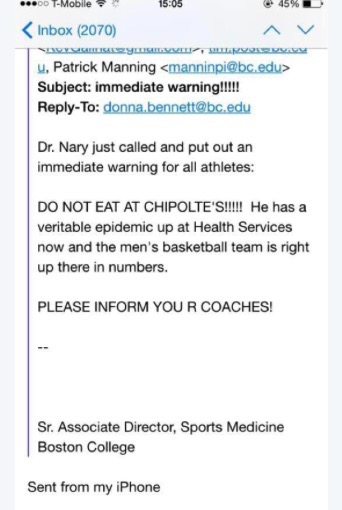Boston College Health Services is confirming that at least 30 students, including 8 basketball players, have come to them complaining of gastrointestinal symptoms, including vomiting and diarrhea. The common factor among all of those sickened, according to BC officials, is that they ate at the Chipotle restaurant in Cleveland Circle.
The Massachusetts Department of Public Health has been notified, and is working to determine if these illnesses are connected to the nationwide E. coli O26 outbreak linked to Chipotle restaurants or if these illnesses are caused by norovirus or another factor. There is no evidence at this time that the illnesses are caused by E. coli bacteria or that Chipotle restaurants are, in fact, involved. The Chipotle restaurant in question at Cleveland Circle has been temporarily closed by the Boston Public Health Commission while officials investigate.
Dr. Thomas Nary of Boston College sent out an email to all students regarding this outbreak:

The Boston College periodical BE Interruption is reporting that the students have E. coli infections, but there is no confirmation of that. The diagnosis of an E. coli infection usually takes days and is only confirmed through a stool sample tested at a lab. The bacteria is then examined for a DNA match to the outbreak strain, which takes days longer.
An email was sent to BC athletes from Patrick Manning about these illnesses.

The E. coli O26 outbreak at Chipotle restaurants has been ongoing since October of this year. The CDC just updated the outbreak numbers on Friday, December 4, 2015, and stated at that time there were 52 ill persons in 9 states; all have been sickened by the same strain of E. coli bacteria.
Massachusetts is not one of the states on the outbreak list. The Chipotle outbreak number is current as of December 2, 2015. Epidemiologic evidence ties the 52 ill persons to Chipotle restaurants, even though no samples taken at the restaurants or of the food served there has yielded E. coli bacteria.
The symptoms of an E. coli infection include diarrhea, which is usually bloody and/or watery, and severe abdominal cramps. A mild fever, nausea, and vomiting may be present. This infection usually takes three to seven days to appear after exposure to the pathogenic bacteria. And people get sick at different times, not all at once.
The symptoms of a norovirus infection include nausea, diarrhea, vomiting, abdominal pain, headache, and a low grade fever. This illness begins one to two days after infection and the symptoms last from twenty-four to sixty hours. Norovirus is extremely contagious and cases increase during the winter months when more people are indoors. Symptoms usually resolve on their own, although in rare cases, people may become so seriously ill that they require hospitalization.




